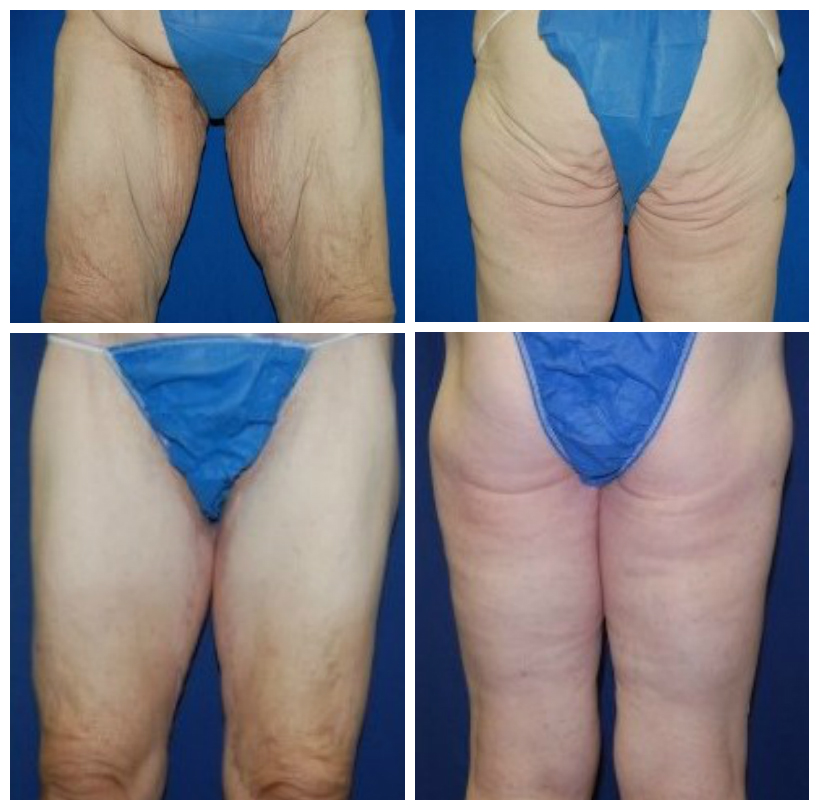Are you at wits end over the loose sagging skin that makes your thighs look flabby and won’t tighten up despite adequate exercise? A thigh lift, the surgical procedure thousands of other similarly frustrated individuals undergo every year, could be the solution for you.
Thighplasty is a body contouring procedure that improves the cosmetic appearance of baggy, excess flesh around the inner and outer thigh area. According to the American Society for Aesthetic Plastic Surgery (ASAPS), thighplasty surgery has been steadily growing in popularity over the past few years. Since 1997 there has been a 491% increase in the number of thigh lifts performed in the United States, with a total of 16,936 performed in 2015.
A large majority of thighplasty procedures are performed on patients who have already experienced significant weight loss on their own or as a result of bariatric surgery. Unfortunately, in cases where skin laxity is too great, following a healthy diet combined with aerobic exercise or resistance training alone won’t necessarily rectify the problem.
“Under these circumstances patients are dramatically healthier and frequently feel much better about themselves, however they remain very frustrated with their thighs and lower extremities. This is because the improved distribution of fat in their bodies also results in sagging and loose skin,” says Dr. R. Brannon Claytor, a prominent plastic surgeon based in Bryn Mawr, PA. Once skin has been stretched excessively it becomes significantly damaged, preventing it from being able to retract naturally.
Research shows approximately 75% of women and 68% of men seek body contouring after massive weight loss. Approximately 27% of these patients will have a thighplasty, while the remaining 73% will undergo a full body lift, which may include a tummy tuck, arm lift and breast lift.
“The majority of thighplasty procedures are most definitely performed on women,” says Dr. Claytor. “Not infrequently this patient population is in the divorced or widowed category. As a result, they are eager to put their best foot forward as they’re actively looking for a future companion. The thighplasty is a significant improvement for lower extremity aesthetics and is, for these reasons, a more attractive procedure to women.”
How Thighplasty is Performed
There are two types of thigh lift procedures: a medial (inner) thigh lift and a lateral (outer) thigh lift. Both types are performed under general anesthesia.
“The medial thighplasty is a complicated procedure that should only be undertaken by a board-certified plastic surgeon who has expertise in body shaping. The complications for this can be catastrophic if safety precautions have not been optimized,” says Dr. Claytor.
To perform the medial thigh lift, an incision is made along the groin crease. If there is extensive skin that needs to be removed, the incision may go as far as the knee on the inner side of the thigh. Liposuction is sometimes performed to remove excess fat before the incision is closed using sutures.
An outer thigh lift is a slightly more complex procedure, focusing on contouring the buttocks and thighs and removing more tissue. The incision starts at the groin, extends around the hip and may include a buttock fold incision.
A thighplasty is performed on both the left and right leg simultaneously and takes anywhere from 1.5 to 3 hours to complete depending on the amount of excess skin excised.
Thigh Lift Cost
According to the ASAPS, the national average cost of surgeon fees for a thigh lift in the United States is $4,933. It should be noted, however, that these figures only cover the practitioner costs and do not include the surgical facility, required garments, anesthesia or any medical tests and prescriptions you might need.
There could be other miscellaneous costs you might incur – each plastic surgeon will provide you with a complete price breakdown upon consultation. You should also be aware that, since this is an elective surgery, health insurance will not cover it.
Side Effects and Complications
“One of the most common complications with thighplasty is when cosmetic results don’t match the patient’s expectations,” states Dr. Claytor. “During initial consultations, this is an important part of the discussion.”
Wound dehiscence—when a wound ruptures along the incision—is another complication that can occur in some patients. Dr. Claytor continues, saying, “This can happen for a variety of reasons. The patient may have poor nutrition or could be a smoker who hasn’t been completely honest about their smoking history.”
For a smoker undergoing this procedure, there is a 6.5-fold increased risk of overall complications and an 11-fold risk of hematoma (a solid swelling of clotted blood within the tissues that can resemble bruising). “Lifestyle factors can compound and challenge the body’s efforts for healing,” adds Dr. Claytor.
So don’t risk complications by excluding pertinent information. If you’re considering undergoing plastic surgery of any kind, it’s smart to be completely honest about your current lifestyle habits and health status during your initial consultation.
DVT—deep vein or deep venous thrombosis—is another potential complication, and a very scary one at that. DVT results from clots that develop in the legs. “Patients that have increased pressure, as well as patients who are disinclined to get up and walk around,” Dr. Claytor cautions, “are at increased risk of developing DVT. The clots can break off, travel to the lungs and cause a pulmonary embolism.” This is a condition where one or more arteries in the lungs become blocked by a blood clot. “Pulmonary embolism can be a life threatening complication,” says Dr. Claytor. “Determining if the patient is at risk for this is an important part of the preoperative evaluation.”
Finally on the list of possible complications is infection. “All patients are given intravenous antibiotics at the time of surgery, which does help protect them from infection,” expounds Dr. Claytor. “But, as a means of combatting any infection, it’s imperative patients follow the detailed instructions for postoperative hygiene that their surgeon provided them with.”
While this information is indeed quite daunting, its purpose is to inform and prepare you for everything that can occur. In general, the majority of complications with thighplasty operations are minor, occurring at a rate of 4.7 to 6.6% with infections and hematoma being the two most common.
For a smoker undergoing this procedure, there is a 6.5-fold increased risk of overall complications and an 11-fold risk of hematoma.
Thigh Lift Scars
Minimal scarring is always the surgeon’s objective. Unfortunately, because a thighplasty often requires a long incision, it’s not possible to leave a patient with zero scarring. Furthermore, scarring from the outer thigh lift will be more extensive than that from the inner.
Dr. Claytor explains that in recent years there have been many advances in the effort to leave only the most minimally visible scars after a thighplasty. Nevertheless, even with a common procedure like an inner thigh lift you should still expect it to leave a scar that runs from the groin to the knee on the inside of the leg.
“In terms of the quality of the scar, combining liposuction at the time of the medial thighplasty often results in discontinuous undermining,” says Dr. Claytor. “This allows for nerve and blood vessels to maintain their attachment from deeper structures up to the skin, while permitting that tissue to be mobilized and closed under minimal tension with absorbable sutures and, therefore, optimal scarring.”
“To help diminish their appearance, excessive scarring can be managed by revisions, massage and creams,” adds Dr. Claytor.
Thigh Lift Recovery

“Post operatively, depending on the amount of tissue removed, the patient will either first be wrapped in ace wrap and then transitioned into custom compression garments that help shape the legs and assist with swelling,” says Dr. Claytor, “or they will immediately have custom garments placed on them after surgery. In the early phase, I tend to favor the ace wrap technique in anticipation of swelling and minimal drainage.”
“Patients will receive some degree of pain medication to help mitigate their post operative discomfort and are expected to be out of their hospital garments day one post- op so they can shower.” says Dr. Claytor. “We want them up and walking around immediately after surgery as this significantly reduces the incidence of deep vein thrombosis.”
Dr. Claytor elaborates, “At two weeks, or half way toward full recovery, patients should be able to walk briskly and perform minimal exercises with their upper and lower extremities. It takes about one month to a full recovery, at which point patients can engage in more aggressive, strenuous activities like playing tennis.”









